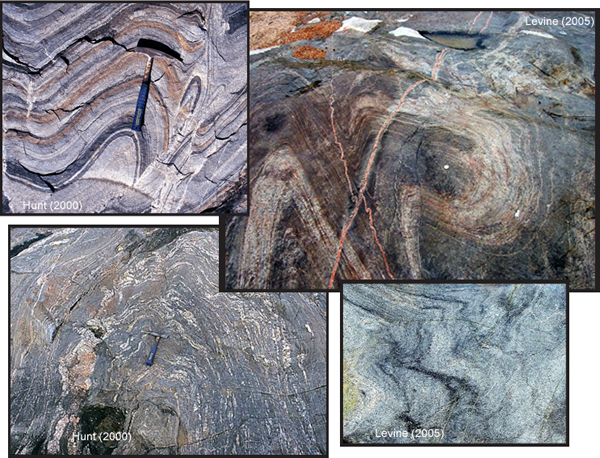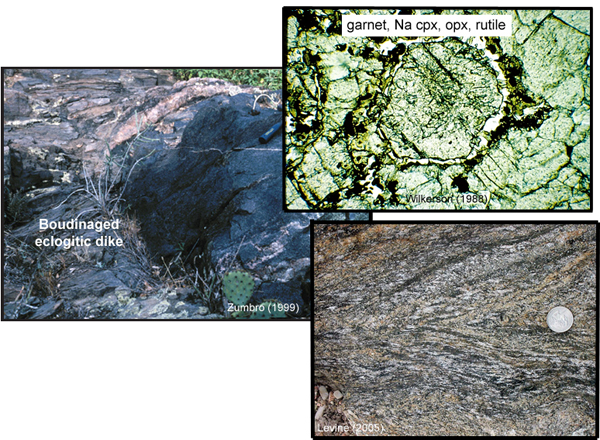|
The western third of the uplift contains the highest pressure metamorphic rocks
indicating continental subduction to depths of 50-70 km. The Coal Creek domain (CCD) is not exposed, and much of the
Packsaddle/Valley Spring (PSD/VSD) domain boundary has been
intruded by a pre-deformational plutonic body (Lost Creek Gneiss - LCG) (Hunt,
2000). Deformation is widely distributed and no shear zones have been identified
(other than late minor local zones). The dominant fabrics and contacts between the PSD/LCG/VSD dip northeast,
showing the opposite structural stacking as in the
eastern uplift (Hunt,
2000; Levine, 2005).
|

The contact between the Packsaddle
and Valley Spring domains in the western uplift
was intruded by a 1254 +6/-4 Ma granitic pluton (Lost Creek Gneiss;
above) prior to regional deformation and metamorphism. The intrusion has
been affected by the same deformational phases as the intruded PSD & VSD.
Different granitic phases (and schlieren) show early folding (e.g. F2
folds with an axial planar S2; above left) whereas later deformation
also affects the dominant S2 fabric (e.g. late extension of S2 results
in grantic melts in small scale shear zones and boudin necks; above
right). (See Hunt, 2000). |
Deformation

Five phases of synmetamorphic deformation produced
multiple fabrics and associated folds (above/below).
The polyphase folding is similar (but locally
more complex)to
that of the eastern uplift, but with
different kinematics. The
dominant regional fabric is a composite of S1/S2 and
appears to be correlative with that in the
eastern uplift. Early phases
of deformation in both PSD &
VSD are intimately associated with partial melting and intrusions (above/below);
later phases predate and postdate late
stage intrusions.
(See Roback et al., 1999;
Hunt, 2000;
Levine, 2005).
|
Metamorphism

Remnant eclogitic bodies
(photomicrograph upper right) yield temperatures of ~750 °C and
pressures declining from ~2.1 GPa to ~1.5 GPa (Carlson et al., in press;
Wilkerson et al., 1988;
Carlson, 1998;
Carlson and Schwarze, 1997).
Excellent exposures of these relict eclogites in the central uplift
(left) show that these bodies represent boudinaged mafic sills (Zumbro,
1999). Subsequent
dynamothermal metamorphism in the western uplift occurred at medium
pressures above the second sillimanite isograd. Aligned
sillimanite, as well as leucosomes, define S1-S3 fabrics (e.g. F3 fold
of S2 with S3 axial planar; sillimanite parallel to both fabrics; lower
right). |
Eastern Llano Uplift
|